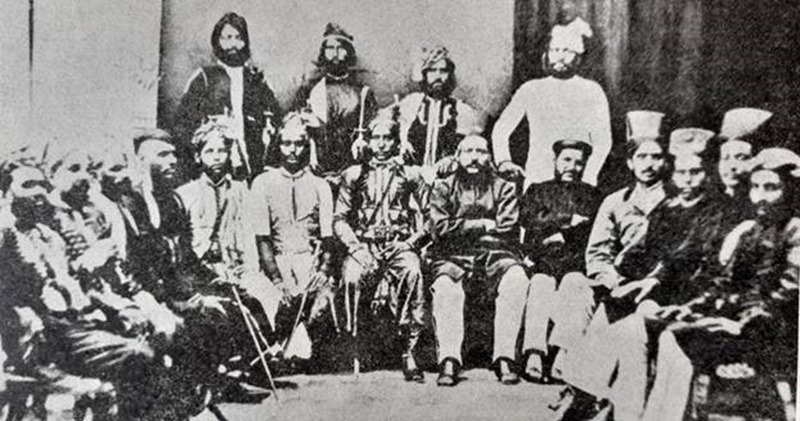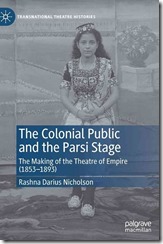This book explores how theatre enabled Parsis to negotiate the growing challenges of colonialism
In ‘The Colonial Public and the Parsi Stage’, Rashna Darius Nicholson is particularly interested in exploring how theatre impacted the life of Parsi women.
Parsi theatre company at Ramprakash Theatre, Jaipur, 1880.
In 1969, when the last vestiges of Parsi theatre could still be seen in Calcutta, Somnath Gupt, a professor of Hindi at Rajasthan University in Jaipur, published a book-length account of Parsi theatre. His engagement with the subject was motivated by his interest in the language which had long dominated Parsi theatre: Hindi or Urdu or Hindustani as it was known in the nineteenth century.
Gupt’s book was preceded by two books in Urdu: Urdu Drama aur Stage by Sayyed Masood Hasan Rizvi Adeeb (1957) and Abdul Aleem Nami’s multi-volume Urdu Theatre which was published in the 1960s. Both Adeeb and Nami mediated their engagement with Parsi theatre through its language of performance. Gupt’s primary sources were the theatre memoirs written by two Parsis, Dhanjibhai Patel and Jehangir Khambata (1914). Dhanjibhai Patel’s reminiscences were first serialised in the Gujarati newspaper Kaiser-i-Hind and then collected into two volumes; no copies of the first volume seem to have survived but the second volume (1931) is available in many libraries. However, Kaiser-i-Hind was then still in existence and Gupt could excavate the original articles from its archives.
Numerous other books on Parsi theatre were published in Hindi and Urdu in the following decades; for example, Hindi rangamanch ke vikas mein Bambai ka yog (The role of Bombay in the development of Hindi theatre) by Devesh Sharma (1987) and Parsi Theatre edited by Ranveer Singh (1990). Perhaps the only Gujarati book on this subject is Purano Parsi Natak Takhto (The old Parsi theatre) by S D Shroff (Firozgar) which was published in 1950. Shroff interviewed numerous retired Parsi theatre artistes while writing this book.
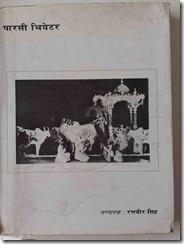 Parsi Theatre edited by Ranveer Singh, Jodhpur, 1990.
Parsi Theatre edited by Ranveer Singh, Jodhpur, 1990.
There have been very few attempts in English to document and analyse Parsi theatre through all the stages of its century-long existence. Rashna Darius Nicholson steps in to fill the breach with The Colonial Public and the Parsi Stage: The Making of the Theatre of Empire (1853–1893). Originally written as a doctoral dissertation, it has been published as a print-on-demand book by Palgrave Macmillan in their “Transnational Theatre Histories” series.
While Nicholson starts off by describing her book as “a history of the Parsi theatre”, it is much more than that. It is also an account of how the members of the Parsi community, as individuals and in groups, negotiated the challenges which an ever-expanding colonial nimbus showered upon it. She proposes the emergence of a Parsi “public sphere” in the 1830s and 1840s as the stage on which Parsi theatre began to be performed from 1853. She is particularly interested in exploring how these developments impacted the life of Parsi women who led largely regimented and secluded lives, not dissimilar to the harshest zenana.
Nicholson adds, “This book, however, does not simply map the shifts that took place through the theatre between physical and discursive bodies, between the construction and deconstruction of women as repositories of communal and national values; it also interrogates how these rhetorical manoeuvres are rendered legible by the material yet hidden body of the archive.”
As this quotation illustrates, the book is written in a high academic register and most readers interested in Parsi theatre would struggle to keep pace with it. But if they do so, they will be richly rewarded. They will get to experience the hurly burly of a rumbustious theatre culture complete with tyrannical directors, traitorous actors, flying machines, extravagant backdrops, and the occasional cross-dressing spectator. They could enter the hallowed portals of the Victoria Theatre where “respectable Parsi men and women” ran the risk of rubbing shoulders with “low class Muslims”. At the Delhi Durbar of 1877, they could choose to patronise either the Victoria Natak Mandali or the Elphinstone Theatrical Company. Upcountry, they could experience the adulation which Parsi actors and directors enjoyed in Indian princely states such as Jaipur and Baroda; and, in one episode more fantastic than Parsi theatre itself, forage for diamonds in silver coconuts in fin de siècle Burma.
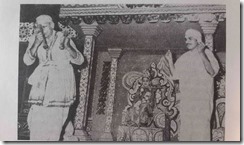 Master Fida Husain in the role of Narsi in the drama, Narsi Mehta, 1950s
Master Fida Husain in the role of Narsi in the drama, Narsi Mehta, 1950s
Like her predecessors, Nicholson mainly relies on the theatre memoirs of Patel and Khambata for primary information on Parsi theatre. But she ventures deeper into the nineteenth century with an exhaustive, and what must have been exhausting, survey of contemporary newspapers to understand how theatre unfolded in the public press. Unfortunately, of the early Gujarati newspapers, only Rast Goftar has survived the depredations of the twentieth century and she makes excellent use of it, as she does of Kaiser-i-Hind and the Bombay Times.
Nicholson, like most Parsi scholars of her generation, was, self-confessedly, bereft of Gujarati – the primary language of the Parsis for centuries until the 1960s – before she embarked on her research. However, unlike most of her peers, she was willing to ascend the learning curve to make use of the extensive Gujarati material which undergirds her work. As Nicholson mines her sources to understand the actions and reactions of the Parsi community in relation to theatre, she uncovers the roots of many of the anxieties that plagued the community post-independence and have been analysed by the anthropologist Tanya Luhrmann in her book The Good Parsi (1996). In the late 1880s, after the formation of the Indian National Congress, these anxieties played out in both the editorial and letters columns of Rast Goftar where the Parsis struggled to discover ‘their proper position in the confusion of races and denominations inhabiting India’.
Nicholson could have engaged more with the pre-1853 choices that Parsis had when it came to entertainment and public performance. They not only went to the Grant Road Theatre in the 1840s to see European performers but also frequented other informal venues where a wide variety of entertainments were offered by Indian performers. A number of Parsi men (and perhaps women) were skilled in singing and playing instruments and regularly entertained their compatriots.
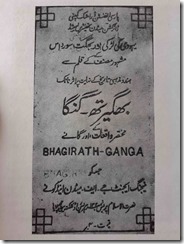 Songbook for Bhagirath-Ganga, Parsi Elphinstone Dramatic Company published by Madan Theatres Limited, Calcutta
Songbook for Bhagirath-Ganga, Parsi Elphinstone Dramatic Company published by Madan Theatres Limited, Calcutta
There was widespread interest in Urdu poetry as evidenced by the number of Bombay imprints in Urdu (in Gujarati script) published by Parsis. She does not take notice of the event which catalysed the Parsi theatre into existence: the first tour of Vishundas Bhave and his Hindu Dramatic Corps to Bombay during 1852-53 and their ticketed performances, both in the Black Town and the Grant Road Theatre. The role of Bhau Daji, the secretary of the first Parsi theatrical committee, and who was instrumental in getting Bhave to perform at the Grant Road Theatre, has also been given short shrift.
At some unspecified time during the years of rapid growth, Parsi theatre began the transition to no longer being just Parsi. Nicholson traces the beginning of this long phase to the 1870s when Parsi theatre troupes began to extensively tour north India and south-east Asia. As Parsi theatre began to attract new audiences in the hinterland, it tailored its performances to local tastes. In turn, local entertainers began to adapt Parsi theatre to their own performance protocols and also joined Parsi theatre troupes.
The word “Parsi” when associated with “theatre” began to assume new meanings, none of which had any relation to its erstwhile association with the community. In the mid-1890s, after four decades of existence, Parsi theatre entered what some commentators have termed as its “golden era” and became “the theatre of empire” as Nicholson aptly puts it. This era, when Parsi theatre dominated mainstream entertainment across North India from Peshawar to Calcutta via Bareilly, lasted until the early 1930s.
But once movies with sound began to gain ground, the fortunes of Parsi theatre nosedived. It survived in a few pockets for another three decades before it completely disappeared. The mantle of Parsi theatre fell on film while theatre in India took other directions. However, the “golden era” of Parsi theatre has hardly been documented or studied by theatre historians with Parsi-Hindi Rangamanch (1972) written in Hindi by Lakshminarayan Lal perhaps being an exception.
Nicholson also does not venture beyond the nineteenth century and has chosen to terminate her current study in 1893, a year in which, she notes, “moving pictures” were first invented. This event, however, did not have any impact on the trajectory of Parsi theatre. Eighteen ninety-three was also the year when Bombay was convulsed by riots. This was the first time that the Parsis were neither agents provocateurs nor active participants in nineteenth century Bombay riots.
This non-participation presaged a breakdown of the economic, political, and social power structures which the Parsi community had built for itself in colonial India and forecast their eventual marginalisation from the Indian mainstream, similar to the one they had experienced in Parsi theatre itself. One could conclude, like the author does, that, “…[t]hrough a syncopation of irruptions, insertions, blurrings, and exorcisms, the colonial Parsi drama as archive bore witness to a specific regularity of events, words, and ideals yet as an embodied, evanescent form not dissimilar to collective memory, it was also constituted by its own self-effacement, making history by forgetting it.”
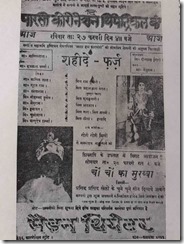 Handbill for performance by Parsi Coronation Theatrical Company at Madan Theatre, Calcutta, 1932
Handbill for performance by Parsi Coronation Theatrical Company at Madan Theatre, Calcutta, 1932
It would be churlish to take issue with the trifling errors that have crept into the text, but one hopes they will be weeded out. For example, the Zoroastrians are described as having “fled for the coast of Gujarat” from Iran “between 8 and 10 CE” where “between the eighth and tenth centuries” was intended. The Cama family is described as acquiring Mumbai Samachar in 1832 from Furdoojee Murzban though their association with the newspaper began a century later; and Munshi Talib is characterised as a Muslim playwright while his name Vinayak Prasad suggests otherwise. However, readers will be curious to know why the copyright of the images reproduced in the book from one of the theatre memoirs has been attributed to the repository where the author referred to it.
The arena of Parsi theatre continues to remain a vast field for research. The careers of individual artistes and troupes have yet to be studied in detail. Play scripts and songbooks related to Parsi theatre were published in their hundreds – in Hindustani and other languages – but printed in Devanagari, Gujarati and Perso-Arabic scripts. These need to be documented and analysed. The archives of princely states who were generous patrons of Parsi theatre need to be examined. Photographs and souvenirs which are still in private possession need to be conserved. All the elements of theatre – song, lighting, art, costume, makeup – need to be investigated. The public and governmental response to Parsi theatre across India needs to be understood. Scholarly studies about Parsi theatre published in its own languages – Hindi, Urdu, and Gujarati – also need to be considered. It is hoped that a phalanx of committed and talented scholars will, like Rashna Nicholson, step forward to accept this challenge.
This article first appeared in Parsiana.
The Colonial Public and the Parsi Stage: The Making of the Theatre of Empire (1853–1893) by Rashna Darius Nicholson, Palgrave Macmillan

